Key takeaways:
- Child safeguarding practices require individualized approaches and active listening to meet each child’s unique needs.
- Effective policymaking hinges on inclusion of diverse perspectives and grounding policies in research to create impactful solutions.
- Challenges such as inconsistent policy application and emotional fatigue among frontline workers can hinder effective safeguarding.
- Strategies for improvement include enhanced inter-agency collaboration, continuous training for workers, and involving children and families in policymaking.
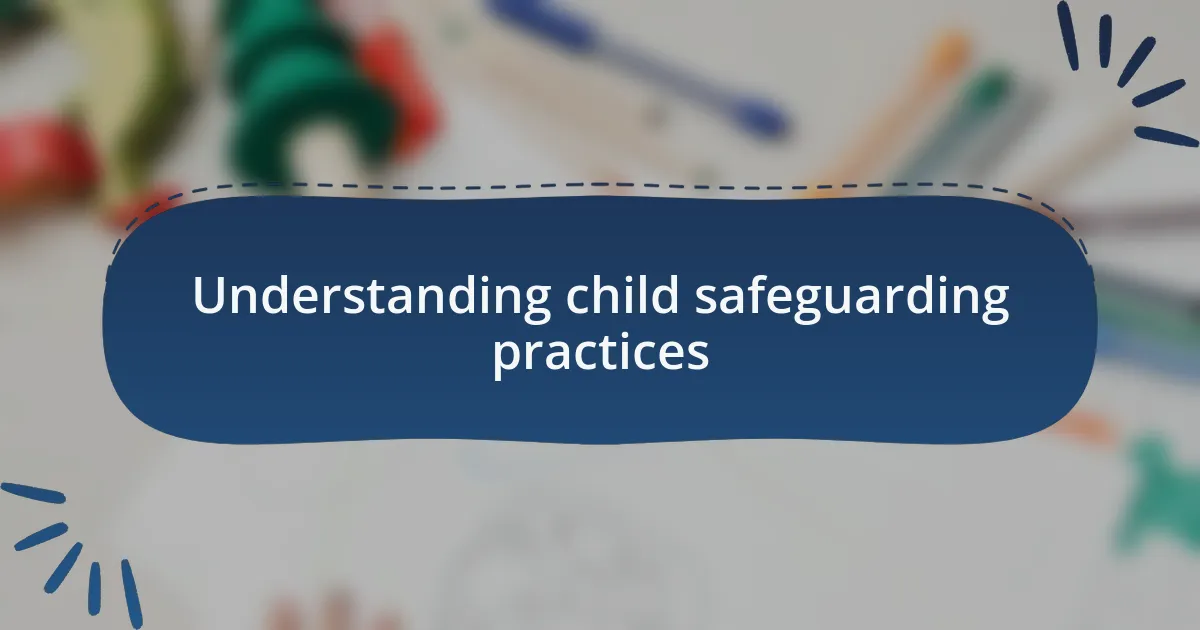
Understanding child safeguarding practices
Child safeguarding practices are essential for protecting the most vulnerable members of our society. I still remember my first encounter with a child protection case; the sense of urgency I felt made me realize just how crucial these practices are. It leads me to wonder, how can we create environments where children feel safe and valued?
Understanding these practices means recognizing the importance of prevention and intervention strategies. I encountered a situation where a simple conversation with a child led to revealing concerns that might have otherwise gone unnoticed. It’s a stark reminder that listening and being present can make all the difference.
Moreover, each child is unique, and safeguarding approaches must be tailored accordingly. Think about it: what works for one child may not work for another. I’ve seen the power of individualized attention in action, illustrating how crucial it is for us to adapt our methods to meet each child’s distinct needs.
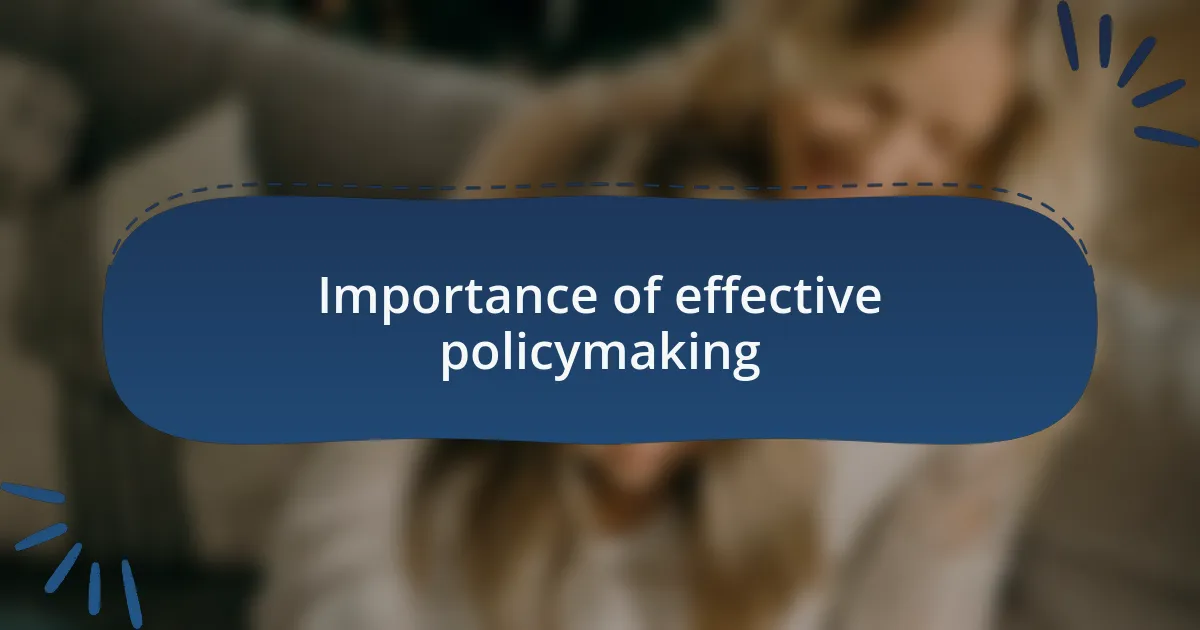
Importance of effective policymaking
Effective policymaking is the backbone of any successful child safeguarding initiative. I recall vividly a policy meeting where stakeholders debated strategies for prevention. The discussions highlighted how well-crafted policies not only set a clear direction but also empower those on the front lines to make informed decisions, ensuring that the best interests of children remain at the forefront.
When policies are grounded in solid research and data, they resonate more strongly with the community. I remember attending a workshop where we analyzed past incidents of child neglect; this analysis helped shape a new policy focusing on early intervention. It was inspiring to witness how evidence-based policymaking can create a tangible impact on children’s lives, fostering an environment where they can thrive.
Moreover, inclusive policymaking that considers diverse perspectives leads to more robust and effective solutions. During my time volunteering in various child welfare organizations, I saw firsthand how the inclusion of voices from different cultural backgrounds enriches policy development. Isn’t it true that the best ideas often come from those who are directly affected by the issues at hand? By actively engaging families and communities, we lay the groundwork for policies that reflect true understanding and empathy.
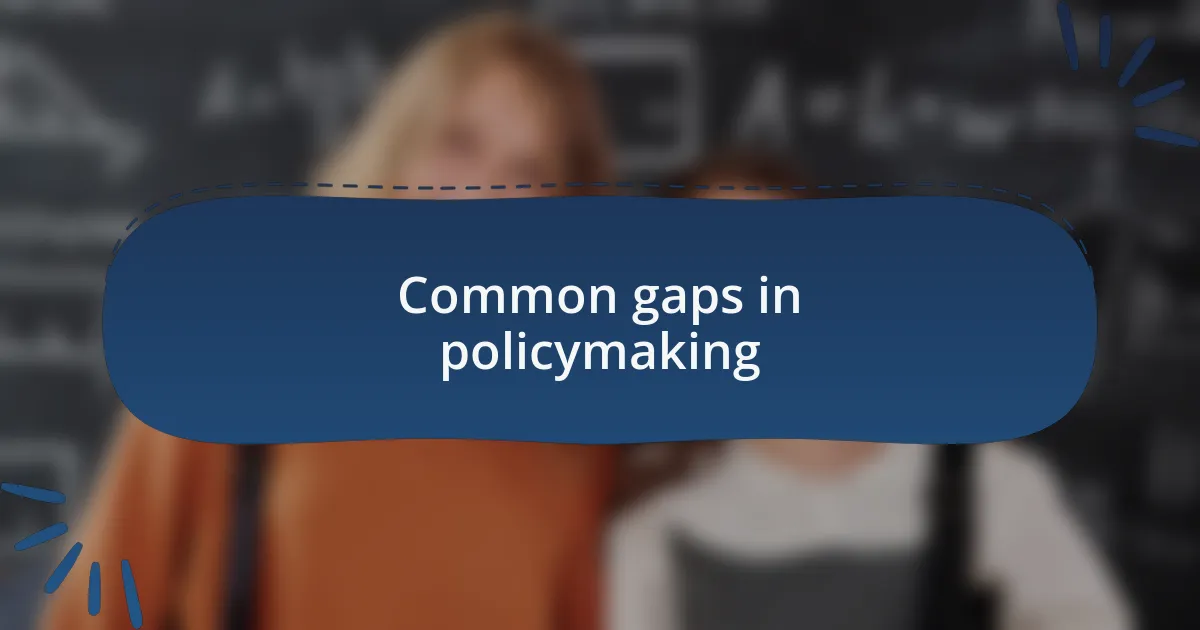
Common gaps in policymaking
Policymaking often misses the mark due to a lack of communication between stakeholders. I once participated in a session where social workers expressed frustration over policies that didn’t align with the realities they faced daily in the field. This disconnect can result in policies that are too theoretical, lacking the practical input needed to ensure they are effective and truly supportive of children.
Another frequent gap is the failure to address intersectionality, which recognizes that individuals have overlapping social identities that can impact their experiences. I remember working alongside colleagues from various backgrounds, and we often discussed how children from marginalized communities faced unique challenges that were overlooked in mainstream policies. If we fail to account for these complexities, we risk creating solutions that are one-size-fits-all and ultimately ineffective.
Perhaps the most troubling gap is the short-term focus of many policies, which often neglects the long-term needs of children. I recall a project aimed at immediate safety measures that didn’t consider the psychological effects of trauma on child development. How can we claim to safeguard children when our policies are reactive rather than preventative? Addressing such oversight is crucial for fostering sustainable environments where children can not only survive but truly flourish.
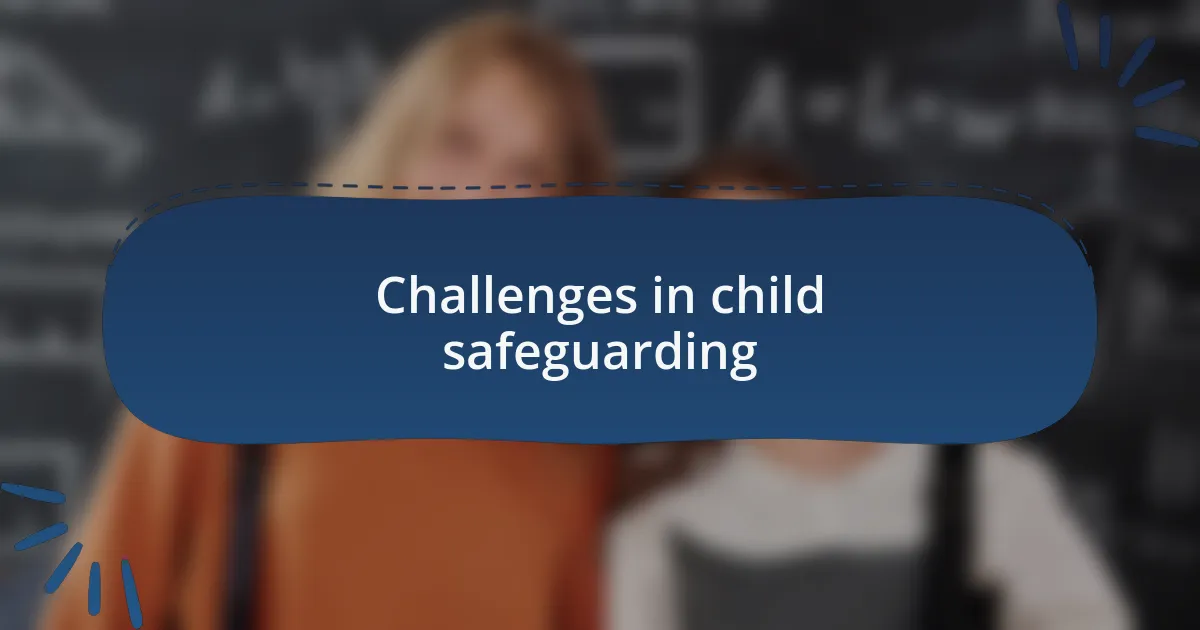
Challenges in child safeguarding
Navigating the complexities of child safeguarding presents numerous challenges that can impede effective policymaking. One notable challenge I encountered during a community workshop was the lack of resources dedicated to training those on the front lines. When social workers feel overwhelmed and inadequately prepared, they may unintentionally overlook critical signs of distress in children. This gap not only affects individual cases but can create a ripple effect across the community, leaving vulnerable children without the protection they need.
Another significant challenge I’ve noticed is the inconsistent application of policies at different levels of government. I remember speaking with a school counselor who seemed disheartened by the variations in safeguarding practices across districts. This inconsistency can breed confusion for caregivers and educators alike. How can we expect everyone to take effective action when there isn’t a clear, unified framework guiding their efforts? It’s crucial that everyone involved in child welfare operates within the same parameters for safeguarding to truly be effective.
Moreover, emotional fatigue among caregivers and frontline workers often goes unaddressed. I was struck by a conversation I had with a pediatrician who shared their struggles with burnout, resulting in a lack of attention to detail in their assessments. This exhaustion can lead to errors and oversights that directly impact children’s safety. But how do we prioritize the mental well-being of those tasked with protecting the most vulnerable? Without supporting our workforce, we risk diminishing the quality of care and safeguarding that children receive.
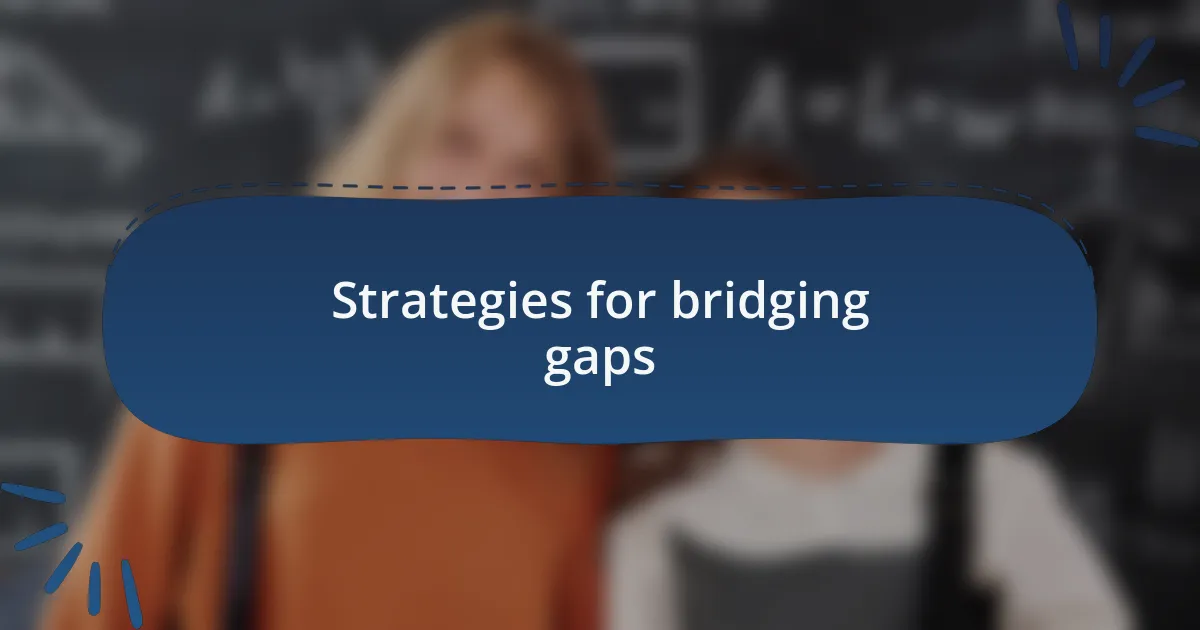
Strategies for bridging gaps
One effective strategy for bridging gaps in child safeguarding is enhancing inter-agency collaboration. I remember attending a roundtable discussion where representatives from different organizations shared their experiences and best practices. It was eye-opening to see how pooling resources and knowledge can create a stronger response to safeguarding issues. Can you imagine the difference it could make if social workers, educators, and healthcare professionals communicated more routinely? Together, they could develop a holistic approach that addresses the multifaceted needs of children in distress.
Another important strategy is the implementation of continuous training and support for frontline workers. In my experience, providing regular workshops not only empowers these individuals but also fosters a sense of community among them. I once participated in a training session that recentered our focus on self-care; that day, I realized just how vital taking breaks can be for avoiding the fatigue that clouds judgment. When these workers feel supported, they’re likely to be more attentive and effective in their roles, ultimately benefiting the children they serve.
Lastly, involving children and families in the policymaking process creates a significant impact. I’ve seen how powerful it is when young voices are included; it allows for policies that truly reflect their needs and concerns. When a teen shared her story of navigating the system, the room went silent. It was a poignant reminder that those directly affected often have the best insights. So, why not give them a seat at the table? This engagement can not only lead to more tailored policies but also instill a sense of ownership and empowerment among families and communities.
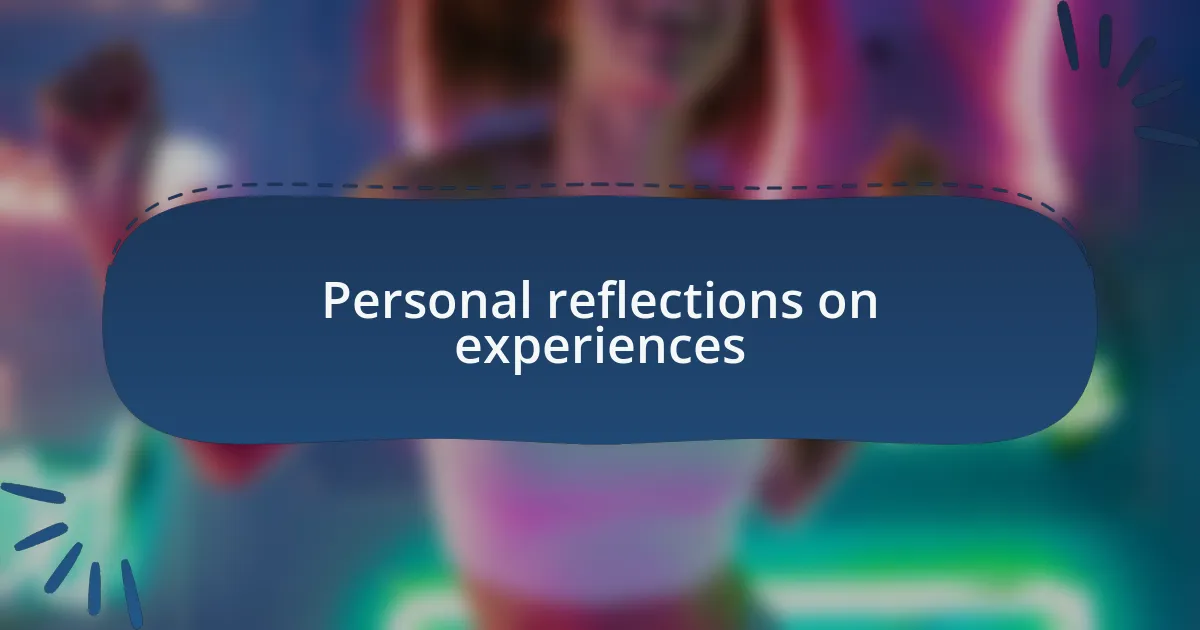
Personal reflections on experiences
Reflecting on my experiences, I can’t help but think of a particular case where I worked closely with a family navigating a safeguarding crisis. The frustration and fear in their eyes were palpable—moments like these remind me why advocating for their voices in policy discussions is so crucial. Have you ever witnessed how trust can transform a tense situation? It felt like we were not just addressing a problem but paving a path for understanding and cooperation.
I also recall an encounter with a volunteer who had dedicated her life to supporting children in need. During our conversation, she opened up about her own childhood experiences of feeling invisible. It struck me deeply; her journey underscored the importance of integrating personal stories into policy frameworks. How many children might feel less alone if their stories were recognized and valued in our decision-making processes?
In a recent focus group I facilitated, we discussed the challenges facing children with disabilities. One participant, a mother, shared her frustration with existing policies that didn’t accommodate her child’s needs. Her passion as she spoke was infectious, making it clear that we were missing out on vital insights when we didn’t actively seek out these experiences. How can we create effective policies if we ignore the very voices that could guide us? These moments stay with me, reinforcing the idea that real change begins with empathy and understanding.

Future directions for child safeguarding
As I reflect on future directions for child safeguarding, I often consider the role of technology in enhancing our approach. I once attended a workshop that showcased a mobile app designed to help report and track cases of child abuse anonymously. It was fascinating to see how the app empowered both children and caregivers to voice their concerns without fear. Have you ever thought about how digital tools could provide a lifeline for those who feel voiceless?
In another instance, I spoke with a group of educators who were eager to implement trauma-informed practices in their schools. During our discussion, they shared heartwarming stories about how such approaches transformed their environments. It made me realize how essential it is for policies to not only support educational settings but also ensure they are equipped to handle the emotional complexities that children face today. What if our future policies included comprehensive training on these practices for all educators?
Finally, I’m increasingly convinced that collaboration across sectors is vital for effective child safeguarding. A conversation with a local law enforcement officer revealed the gaps between police and social services, which often leads to misunderstandings during crisis situations. This insight has left me pondering: how can we create a more integrated system that prioritizes the child’s well-being over bureaucratic challenges? These conversations highlight a clear path forward, emphasizing the need for connection, education, and shared responsibility in safeguarding our children.